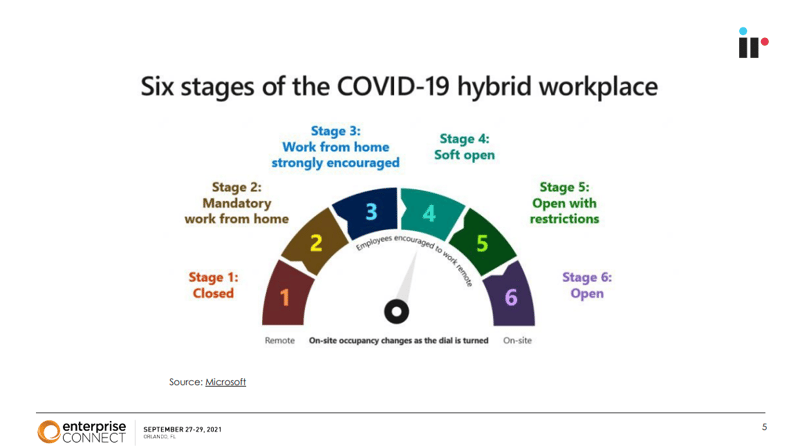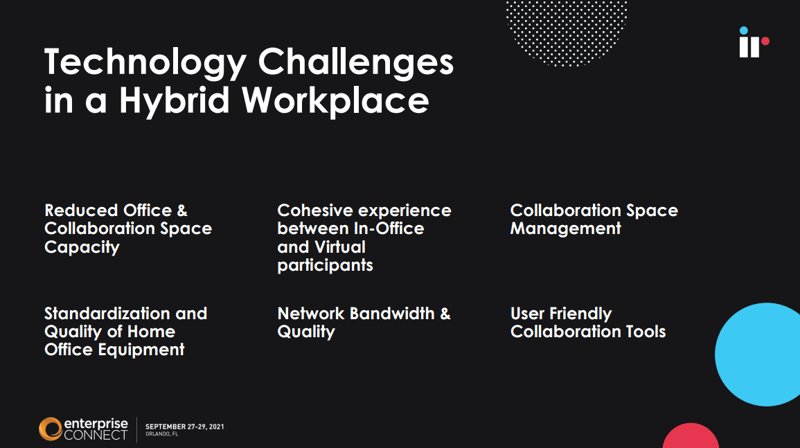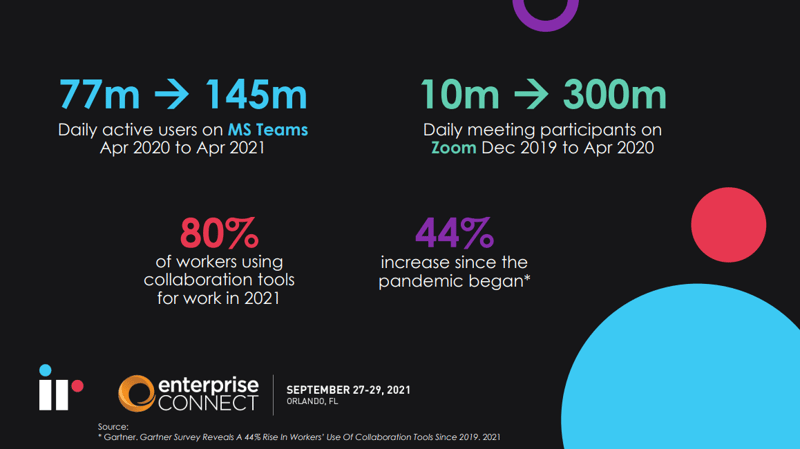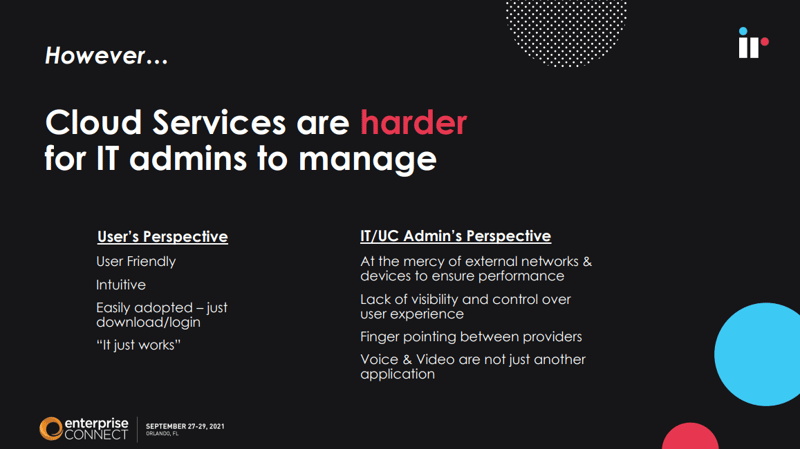Highlights from Enterprise Connect 2021
The Enterprise Connect 2021 virtual conference and expo was held from September 27th - 29th, bringing together corporate IT decision-makers, industry vendors, channel partners, thought-leaders, analysts and consultants. The event focused on the issues central to enterprise communications and collaboration.
With the COVID-19 pandemic as a backdrop, highlights from the conference featured five industry keynotes from Microsoft, Cisco, Zoom, RingCentral and AWS. The event covered a host of expert-led sessions on topics concerning the future of the new working world, including:
- How hybrid and remote working will define the modern workplace permanently
- The rapid evolution and adoption of new technology and how it has changed enterprise operations
- The effects of a changing working culture on employees
- The benefits and challenges of change
- The impact of failure of business-critical systems, and how to prevent it
Communications technology: The foundation of an enterprise
Communications technology has always been business-critical, but the COVID pandemic has caused a tectonic shift in the way enterprises function today.
Hybrid working has firmly established that technology is the foundation of an enterprise’s ability to keep employees engaged and support cross-company collaboration.
Enterprise IT and communications decision-makers are having to think strategically about their business, while understanding the technology deeply enough to make the right choices.
Hybrid communication – including everyone
Constantly evolving technology is helping navigate the new realms of communication, making hybrid working possible. For an enterprise to fully gain the benefits of a hybrid working culture, it will rely heavily on establishing the needs of their employees, on every level.
For the best performance, productivity and user experience, organizations will need to try different things to ensure that in this new world of hybrid communication, there is involvement equity across every connection. This means:
- Maintaining inclusivity
- Enabling seamless participation and engagement
- Encouraging empowerment
- Ensuring safety and security
The hybrid work framework
Empowering your employees to accomplish more, no matter where they work, is the key to a successful hybrid working culture.
Employees as partners, not consumers
Encouraging a reformed relationship within the hybrid workplace means engaging employees as partners, instead of consumers.
This gives users a stake in the processes of deploying, accessing and improving technology tools. User experience (UX) for employees should become an internal version of (and as important as) customer experience. It’s no longer acceptable to have a degradation of technology.
Etiquette and psychology
The human factor in communication favors person-to-person contact, whether it’s subconsciously or by habit and conditioning.
For example, in a meeting situation with 6 people in a boardroom face-to-face, and perhaps one or two on a remote screen, it’s easy for remote participants to feel alienated, or not as included in the meeting process. In a hybrid world, it’s important to introduce etiquettes that equalize each participant.
Remote and on-site: Part of the same solution
Hybrid collaboration is critical in the post-COVID working world. According to research and predictions by Gartner, in-person meetings will drop from 60% of enterprise meetings to 25% by 2024. This will be driven by remote working and changing workforce demographics.
Instead of being separate components of a workplace, remote and on-site working have become part of the same plan in order to optimize the workplace needs of employers and enable business continuity and growth.
If the tools don’t work, nothing works
Throughout the COVID pandemic, we’ve established 6 stages which have led to the hybrid work model we have today. We’ve seen progression and regression through these stages several times worldwide.
As a result, in today’s dynamic working environment, where things are constantly changing, communication tools need to work seamlessly, immediately and faultlessly, regardless of where we are, or what stage we’re in.

Thanks to developments in technology, and through the adoption of increasingly sophisticated tools, important enterprise organizations have been able to continue supplying critical services.
Governments can communicate and continue to make decisions affecting nations.
Telehealth consultations are enabling patients and healthcare practitioners to communicate to make health decisions.
The education system can function and provide support for schools and remote learning.
This is all possible because of technology, but with the increasing reliance on this technology to have 100% functionality, IT leaders are facing massive challenges.
Technology challenges
Everyone wants a consistent, reliable collaboration experience. To achieve this, businesses need to provide quality equipment. Standardizing and/or using certified collaboration tools allows workers to access to those tools wherever they are.
Network bandwidth and quality is also important, but there are different levels of quality, so finding reliable, supportive network providers is vital. For remote users with persistently poor quality, they may need to balance their time in the office.

Keeping the hybrid workplace working
The rapid shift to hybrid working came about in response to the pandemic, and now there is little possibility that the modern workplace will go back to the way things used to be. The increase in daily active users of some of the main collaboration platforms is astounding, and these figures are only forecast to grow.

To keep things working the way they should, organizations need to implement tools that keep a close eye on performance throughout every aspect of their unified communications environment.
When a video meeting goes wrong
Everyone is accustomed to things going bad during a video meeting, and most people think they just have to accept it. A bad video call or communication session is not just annoying, or a waste of time – it has serious implications for the user, and for the business. It’s more then just time productivity and efficiency that’s compromised. There’s also the operational cost of troubleshooting and managing and maintaining it all.
A reliance on video technology
Many organizations have come to rely on collaboration tools to deliver the services and the products they’re providing. So, things like virtual classrooms, virtual courtrooms, professional services such as legal, accounting, and consulting companies are seeing video conferencing tools as the lifeblood of their business. It has become how they deliver their service.
Video has enabled us to feel part of the organization, so losing the quality of experience has a massive impact on company culture. If someone is leading a video calling session, and the call goes bad, it creates untold stress. This potentially leads to absenteeism, lack of employee engagement, turnover, meeting fatigue and more.
Cloud services add more complexity
Many organizations are either in the process of migrating to the cloud, or have already done so in varying stages. Cloud-based architecture for UC solutions can provide easy to manage, consistent communication services across numerous office locations, spanning different geographies.
But the reality is that IT admins have less visibility and less control over a cloud based UC environment than when they were managing all these things themselves - from the end user devices, to the network, to the service itself. Now, with cloud services, there are potentially dozens of different providers on each of the end points.
There are multiple network providers for home users; 3G, 4G, different quality of broadband, corporate networks and everything in between. Most of the problems with cloud services are not the cloud service itself, but everything else in between. Lack of visibility creates issues. It becomes difficult to ascertain responsibility for these issues because there is no overall picture of the entire unified communications environment.

A single source of truth
The only way to manage such complex UC ecosystems is to have an ‘all seeing eye’ that encompasses the entire communications environment. You need visibility into every aspect, every component of the system so that you can see clearly what’s gone wrong, where and when it happened and the exact location at which it happened. You need the ability to understand and troubleshoot your network – which can become lost in the cloud.
Troubleshooting the root cause of the issue is impossible without any kind of tool.
Recommendations from Gartner confirm that enterprises should deploy a specialized, third-party monitoring tool, especially when implementing high-end enterprise telephony and video conferencing deployments.
Today’s communication platforms come with their own monitoring tools and their own capabilities. Although these tools do provide some insight, they are focused on their own platforms, and many are focused on reporting and analytics. But the real capability to deeply understand what’s going on across those networks are more often the requirements of specialized monitoring tools.
Most organizations have several different systems and services that they provide. For example, if you use Microsoft Teams in North America, Cisco in Europe, and another tool in Asia, it’s crucial that you have the capability to monitor all of those applications seamlessly.
The widest breadth of visibility
End to end visibility is important to show where things are going wrong. The more granular information you have, the easier it is to pinpoint issues, and identify the cause. A third-party monitoring solution like IR Collaborate provides all this:
- Cross-vendor and hybrid visibility – one solution.
- A mix of cloud-based services and on-premises – one solution provides visibility into everything.
- A detailed media flow shows what’s happening with audio, video, data share – and where issues are occurring.
- The overall health of the service itself as well as the health of the different networks that you’re connecting through.
- Enriched user device information, so whatever is happening on any user’s laptop, mobile device, headset, camera – one solution will help isolate the cause and issue.
- The ability to test your solution at different points in the day.
- Analytics, reporting and benchmarking - important parts of your UC infrastructure.
- Customizable dashboards that give you full visibility so that IT staff always have a view into what is going on with your UC solutions.
In today’s hybrid working world, delivering a high quality of service to end users is paramount. You need to have the capacity to monitor, alert and identify issues across your entire UC ecosystem in real time.





